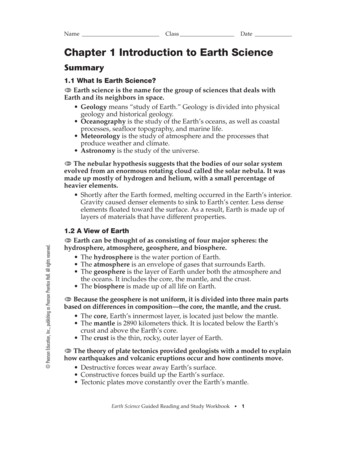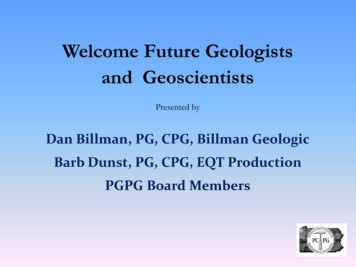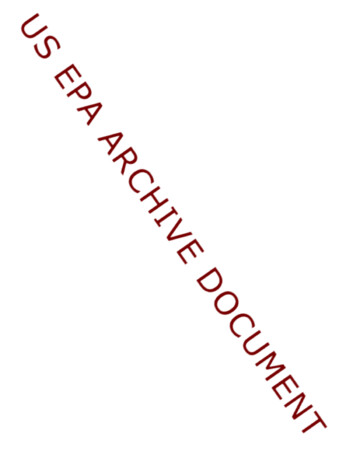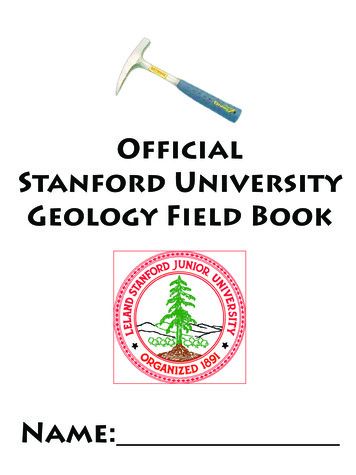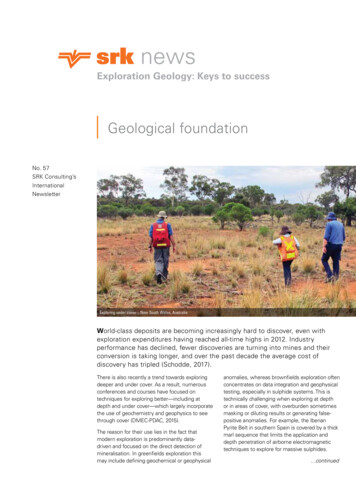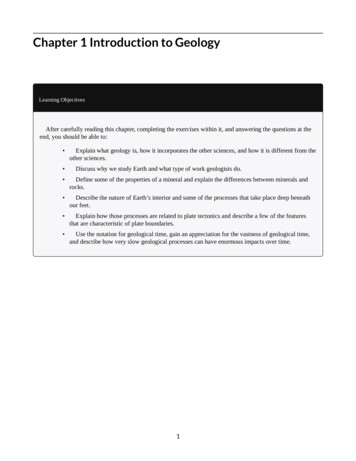
Transcription
Chapter 1 Introduction to GeologyLearning ObjectivesAfter carefully reading this chapter, completing the exercises within it, and answering the questions at theend, you should be able to: Explain what geology is, how it incorporates the other sciences, and how it is different from theother sciences.Discuss why we study Earth and what type of work geologists do. Define some of the properties of a mineral and explain the differences between minerals androcks. Describe the nature of Earth’s interior and some of the processes that take place deep beneathour feet. Explain how those processes are related to plate tectonics and describe a few of the featuresthat are characteristic of plate boundaries. Use the notation for geological time, gain an appreciation for the vastness of geological time,and describe how very slow geological processes can have enormous impacts over time.1
1.1 What is Geology?In its broadest sense, geology is the study of Earth—its interior and its exterior surface, the minerals,rocks and other materials that are around us, the processes that have resulted in the formation ofthose materials, the water that flows over the surface and through the ground, the changes that havetaken place over the vastness of geological time, and the changes that we can anticipate will takeplace in the near future. Geology is a science, meaning that we use deductive reasoning and scientificmethods to understand geological problems. It is, arguably, the most integrated of all of the sciencesbecause it involves the understanding and application of all of the other sciences: physics, chemistry,biology, mathematics, astronomy, and others. But unlike most of the other sciences, geology has an extradimension, that of time—deep time—billions of years of it. Geologists study the evidence that they seearound them, but in most cases, they are observing the results of processes that happened thousands,millions, and even billions of years in the past. Those were processes that took place at incredibly slowrates—millimetres per year to centimetres per year—but because of the amount of time available, theyproduced massive results.Geology is displayed on a grand scale in mountainous regions, perhaps nowhere better than the RockyMountains in Canada (Figure 1.1.1). The peak on the right is Rearguard Mountain, which is a fewkilometres northeast of Mount Robson, the tallest peak in the Canadian Rockies (3,954 metres). Thelarge glacier in the middle of the photo is the Robson Glacier. The river flowing from Robson Glacierdrains into Berg Lake in the bottom right. There are many geological features portrayed here. Thesedimentary rock that these mountains are made of formed in ocean water over 500 million years ago.A few hundred million years later, these beds were pushed east for tens to hundreds of kilometres bytectonic plate convergence and also pushed up to thousands of metres above sea level. Over the pasttwo million years this area—like most of the rest of Canada—has been repeatedly glaciated, and theerosional effects of those glaciations are obvious.The Robson Glacier is now only a small remnant of its size during the Little Ice Age of the 15th to18th centuries, and even a lot smaller that it was just over a century ago in 1908. The distinctive line onthe slope on the left side of both photos shows the elevation of the edge of the glacier a few hundredyears ago. Like almost all other glaciers in the world, it receded after the 18th century because of naturalclimate change, is now receding even more rapidly because of human-caused climate change.2
3 Chapter 1 Introduction to GeologyFigure 1.1.1 Rearguard Mountain and Robson Glacier in Mount Robson Provincial Park, BC. Left: Robson Glacierin 2012. Right: Robson Glacier circa 1908.Geology is also about understanding the evolution of life on Earth; about discovering resources suchas water, metals and energy; about recognizing and minimizing the environmental implications of ouruse of those resources; and about learning how to mitigate the hazards related to earthquakes, volcaniceruptions, and slope failures. All of these aspects of geology, and many more, are covered in thistextbook.What are scientific methods?There is no single method of inquiry that isspecifically the “scientific method”; furthermore,scientific inquiry is not necessarily different fromserious research in other disciplines. The mostimportant thing that those involved in any type ofinquiry must do is to be skeptical. As the physicistRichard Feynman once said: the first principle ofscience is that “you must not fool yourself—and youare the easiest person to fool.” A key feature of seriousinquiry is the creation of a hypothesis (a tentativeexplanation) that could explain the observations thathave been made, and then the formulation and testing(by experimentation) of one or more predictions thatfollow from that hypothesis.For example, we might observe that most of theFigure 1.1.2cobbles in a stream bed are well rounded (see photoabove), and then derive the hypothesis that the rocksare rounded by transportation along the stream bed. A prediction that follows from this hypothesis is thatcobbles present in a stream will become increasingly rounded as they are transported downstream. Anexperiment to test this prediction would be to place some angular cobbles in a stream, label them so that we
1.1 What is Geology? 4can be sure to find them again later, and then return at various time intervals (over a period of years) tocarefully measure their locations and roundness.A critical feature of a good hypothesis and any resulting predictions is that they must be testable. Forexample, an alternative hypothesis to the one above is that an extraterrestrial organization creates roundedcobbles and places them in streams when nobody is looking. This may indeed be the case, but there is nopractical way to test this hypothesis. Most importantly, there is no way to prove that it is false, because if wearen’t able to catch the aliens at work, we still won’t know if they did it!Media Attributions Figure 1.1.1 (left): Steven Earle. CC BY. Figure 1.1.1 (right): A.P. Coleman. Public domain. Source: Arthur P. Coleman Collection atVictoria University Library. Figure 1.1.2: Steven Earle. CC BY.
1.2 Why Study Earth?The simple answer to this question is that Earth is our home—our only home for the foreseeablefuture—and in order to ensure that it continues to be a great place to live, we need to understand howit works. Another answer is that some of us can’t help but study it because it’s fascinating. But there ismore to it than that: We rely on Earth for valuable resources such as soil, water, metals, industrial minerals, andenergy, and we need to know how to find these resources and exploit them sustainably. We can study rocks and the fossils they contain to understand the evolution of ourenvironment and the life within it. We can learn to minimize our risks from earthquakes, volcanoes, slope failures, anddamaging storms. We can learn how and why Earth’s climate has changed naturally in the past, and use thatknowledge to understand both natural and human-caused climate change. We can recognize how our activities have altered the environment in many ways and theclimate in increasingly serious ways, and how to avoid more severe changes in the future. We can use our knowledge of Earth to understand other planets in our solar system, as well asthose around distant stars.An example of the importance of geological studies for minimizing risks to the public is illustrated inFigure 1.2.1. This is a slope failure that took place in January 2005 in the Riverside Drive area of NorthVancouver. The steep bank beneath the house shown gave way, and a slurry of mud and sand floweddown, destroying another house below and killing one person. This event took place following a heavyrainfall, which is a common occurrence in southwestern B.C. in the winter.5
1.2 Why Study Earth? 6Figure 1.2.1 The aftermath of a deadly debris flow in the Riverside Drive area of North Vancouver in January 2005.The irony of the 2005 slope failure is that the District of North Vancouver had been warned in ageological report written in 1980 that this area was prone to slope failure and that steps should be takento minimize the risk to residents. Very little was done in the intervening 25 years, and the consequencesof that were deadly.Media Attributions Figure 1.2.1: The Province. All rights reserved. Used with permission.
1.3 What Do Geologists Do?Geologists are involved in a range of widely varying occupations with one thing in common: theprivilege and responsibility of studying this fascinating planet. In Canada, many geologists work in theresource industries, including mineral exploration and mining and energy exploration and extraction.Other major areas where geologists work include hazard assessment and mitigation (e.g., assessmentof risks from slope failures, earthquakes, and volcanic eruptions); water supply planning, development,and management; waste management; and assessment of geological issues in the forest industry, andon construction projects such as highways, tunnels, and bridges. Most geologists are employed in theprivate sector, but many work for government-funded geological organizations, such as the GeologicalSurvey of Canada or one of the provincial geological surveys. And of course, many geologists areinvolved in education at the secondary and the post-secondary levels.Some people are attracted to geology because they like to be outdoors, and it is true that manygeological opportunities involve fieldwork in places that are as amazing to see as they are interesting tostudy. But a lot of geological work is also done in offices or laboratories. Geological work tends to bevaried and challenging, and for these reasons and many others, geologists are among those who are themost satisfied with their employment.Figure 1.3.1 Geologists examining ash-layer deposits at Kilauea Volcano, Hawaii.In Canada, most working geologists are required to be registered with an association of professionalgeoscientists. This typically involves meeting specific post-secondary educational standards and gaining7
1.3 What Do Geologists Do? 8several years of relevant professional experience under the supervision of a registered geoscientist. Moreinformation can be found at Engineers and Geoscientists British Columbia.Media Attributions Figure 1.3.1: Steven Earle. CC BY.
1.4 Minerals and RocksThe rest of this chapter is devoted to a brief overview of a few of the important aspects of physicalgeology, starting with minerals and rocks. This is followed by a review of Earth’s internal structure andthe processes of plate tectonics, and an explanation of geological time.The Earth is made up of varying proportions of the 90 naturally occurring elements—hydrogen,carbon, oxygen, magnesium, silicon, iron, and so on. In most geological materials, these combine invarious ways to make minerals. Minerals will be covered in some detail in Chapter 2, but here we willbriefly touch on what minerals are, and how they are related to rocks.A mineral is a naturally occurring combination of specific elements that are arranged in a particular1repeating three-dimensional structure or lattice. The mineral halite is shown as an example in Figure1.4.1.In this case, atoms of sodium (Na: purple)alternate with atoms of chlorine (Cl: green) in allthree dimensions, and the angles between thebonds are all 90 . Even in a tiny crystal, like theones in your salt shaker, the lattices extend in allthree directions for thousands of repetitions.Halite always has this composition and thisstructure.Figure 1.4.1 The lattice structure and composition of themineral halite (common table salt).Note: Element symbols (e.g., Na and Cl) are used extensively in this book. In Appendix 1, you will find a list ofthe symbols and names of the elements common in minerals and a copy of the periodic table. Please use thoseresources if you are not familiar with the element symbols.There are thousands of minerals, although only a few dozen are mentioned in this book. In nature,minerals are found in rocks, and the vast majority of rocks are composed of at least a few differentminerals. A close-up view of granite, a common rock, is shown in Figure 1.4.2. Although a hand-sizedpiece of granite may have thousands of individual mineral crystals in it, there are typically only a fewdifferent minerals, as shown here.1. Terms in bold are defined in the glossary at the end of the book.9
1.4 Minerals and Rocks 10Figure 1.4.2 A close-up view of the rock granite and some of the minerals that it typically contains (H hornblende(amphibole), Q quartz and F feldspar). The crystals range from about 0.1 to 3 millimetres (mm) in diameter. Mostare irregular in outline, but some are rectangular.Rocks can form in a variety of ways. Igneous rocks form from magma (molten rock) that has eithercooled slowly underground (e.g., to produce granite) or cooled quickly at the surface after a volcaniceruption (e.g., basalt). Sedimentary rocks, such as sandstone, form when the weathered products ofother rocks accumulate at the surface and are then buried by other sediments. Metamorphic rocks formwhen either igneous or sedimentary rocks are heated and squeezed to the point where some of theirminerals are unstable and new minerals form to create a different type of rock. An example is schist.
11 Chapter 1 Introduction to GeologyA critical point to remember is the difference between a mineral and a rock. A mineral is a puresubstance with a specific composition and structure, while a rock is typically a mixture of severaldifferent minerals (although a few types of rock may include only one type of mineral). Examples ofminerals are feldspar, quartz, mica, halite, calcite, and amphibole. Examples of rocks are granite, basalt,sandstone, limestone, and schist.Key Takeaway: Know the difference between minerals and rocks!If you are currently taking a geology course, you’ll likely be asked more than once to name a mineral or arock that has specific characteristics or composition, or was formed in a specific environment. Please makesure that if you’re asked for a rock name that you don’t respond with a mineral name, and vice versa.Confusing minerals and rocks is one of the most common mistakes that geology students make.Exercise 1.1 Find a piece of graniteThe rock granite is very common in most parts of North America, and unless everything is currentlycovered with snow where you live, you should have no trouble finding a sample of it near you. The bestplaces to look are pebbly ocean or lake beaches, a gravel bar of a creek or river, a gravel driveway, orsomewhere where gravel has been used in landscaping. In Figure 1.4.3, taken on a beach, the granitic pebblesare the ones that are predominantly light-coloured with dark specks. The one in the very centre is a goodexample.
1.4 Minerals and Rocks 12Figure 1.4.3Select a sample of granite and, referring to Figure 1.4.2, see if you can identify some of the minerals in it.It may help to break it in half with a hammer to see a fresh surface, but be careful to protect your eyes if youdo so. You should be able to see glassy-looking quartz, dull white plagioclase feldspar (and maybe pinkpotassium feldspar), and black hornblende or, in some cases, flaky black biotite mica (or both).In addition to identifying the minerals in your granite, you might also try to describe the texture in terms ofthe range sizes of the mineral crystals (in millimetres) and the shapes of the crystals (some may berectangular in outline, most will be irregular). Think about where your granite might have come from andhow it got to where you found it.See Appendix 3 for Exercise 1.1 answers.Media Attributions Figure 1.4.1, 1.4.2, 1.4.3: Steven Earle. CC BY.
1.5 Fundamentals of Plate TectonicsPlate tectonics is the model or theory that has been used for the past 60 years to understand andexplain how the Earth works—more specifically the origins of continents and oceans, of folded rocksand mountain ranges, of earthquakes and volcanoes, and of continental drift. Plate tectonics is explainedin some detail in Chapter 10, but is introduced here because it includes concepts that are important tomany of the topics covered in the next few chapters.13
1.5 Fundamentals of Plate Tectonics 14Figure 1.5.1 The components of the interiorof the Earth (click on the image to see a
15 Chapter 1 Introduction to Geologyfull-size version).Key to understanding plate tectonics is an understanding of Earth’s internal structure, which is illustratedin Figure 1.5.1. Earth’s core consists mostly of iron. The outer core is hot enough for the iron to beliquid. The inner core—although even hotter—is under so much pressure that it is solid. The mantle ismade up of iron and magnesium silicate minerals. The bulk of the mantle surrounding the outer core issolid rock, but is plastic enough to be able to flow slowly. The outermost part of the mantle is rigid. Thecrust—composed mostly of granite on the continents and mostly of basalt beneath the oceans—is alsorigid. The crust and outermost rigid mantle together make up the lithosphere. The lithosphere is dividedinto about 20 tectonic plates that move in different directions on Earth’s surface.An important property of Earth (and other planets) is that the temperature increases with depth, fromclose to 0 C at the surface to about 7000 C at the centre of the core. In the crust, the rate of temperatureincrease is about 30 C every kilometre. This is known as the geothermal gradient.Heat is continuously flowing outward from Earth’s interior, and the transfer of heat from the coreto the mantle causes convection in the mantle (Figure 1.5.2). This convection is the primary drivingforce for the movement of tectonic plates. At places where convection currents in the mantle are movingupward, new lithosphere forms (at ocean ridges), and the plates move apart (diverge). Where two platesare converging (and the convective flow is downward), one plate will be subducted (pushed down)into the mantle beneath the other. Many of Earth’s major earthquakes and volcanoes are associated withconvergent boundaries.Figure 1.5.2 Depiction of the convection in the mantle and it’s relationship to platemotionEarth’s major tectonic plates and the directions and rates at which they are diverging at sea-floor ridges,are shown in Figure 1.5.3.
1.5 Fundamentals of Plate Tectonics 16Exercise 1.2 PlateUsing either a map of the tectonic plates from the Internet or Figure 1.5.3 determine which tectonic plateyou are on right now, approximately how fast it is moving, and in what direction. How far has that platemoved relative to Earth’s core since you were born?Figure 1.5.3 A map showing 15 of the Earth’s tectonic plates and the approximate rates and directions of plate motions.See Appendix 3 for Exercise 1.2 answers.Media Attributions Figure 1.5.1: Steven Earle. CC BY. Figure 1.5.2: Oceanic Spreading by Surachit. Public domain. Figure 1.5.3: Tectonic Plates by USGS. Public domain. Adapted by Steven Earle.
1.6 Geological TimeIn 1788, after many years of geological study, James Hutton, one of the great pioneers of geology,wrote the following about the age of Earth: The result, therefore, of our present enquiry is, that we find1no vestige of a beginning — no prospect of an end. Of course he wasn’t exactly correct, there was abeginning and there will be an end to Earth, but what he was trying to express is that geological timeis so vast that we humans, who typically live for less than a century, have no means of appreciatinghow much geological time there is. Hutton didn’t even try to assign an age to Earth, but we now knowthat it is approximately 4,570 million years old. Using the scientific notation for geological time, thatis 4,570 Ma (for mega annum or “millions of years”) or 4.57 Ga (for giga annum or billions of years).More recent dates can be expressed in ka (kilo annum); for example, the last cycle of glaciation endedat approximately 11.7 ka or 11,700 years ago. This notation will be used for geological dates throughoutthis book.Exercise 1.3 Using geological time notationTo help you understand the scientific notation for geological time—which is used extensively in thisbook—write the following out in numbers (for example, 3.23 Ma 3,230,000 years).1.2.75 ka2.0.93 Ga3.14.2 MaWe use this notation to describe geological events in the same way that we might say “they arrived at 2pm.” For example, we can say “this rock formed at 45 Ma.” But this notation is not used to express elapsedtime. We don’t say: “I studied for 4 pm for that test.” And we don’t say: “The dinosaurs lived for 160 Ma.”Instead, we could say: “The dinosaurs lived from 225 Ma to 65 Ma, which is 160 million years.”See Appendix 3 for Exercise 1.3 answers.Unfortunately, knowing how to express geological time doesn’t really help us understand or appreciateits extent. A version of the geological time scale is included as Figure 1.6.1. Unlike time scales you’llsee in other places, or even later in this book, this time scale is linear throughout its length, meaning that50 Ma during the Cenozoic is the same thickness as 50 Ma during the Hadean—in each case about theheight of the “M” in Ma. The Pleistocene glacial epoch began at about 2.6 Ma, which is equivalent tohalf the thickness of the thin grey line at the top of the yellow bar marked “Cenozoic.” Most other timescales have earlier parts of Earth’s history compressed so that more detail can be shown for the morerecent parts. That makes it difficult to appreciate the extent of geological time.1. Hutton, J, 1788. Theory of the Earth; or an investigation of the laws observable in the composition, dissolution, and restoration of landupon the Globe. Transactions of the Royal Society of Edinburgh.17
1.6 Geological Time 18To create some context, the Phanerozoic Eon (the last 542 million years)is named for the time during which visible (phaneros) life (zoi) is present inthe geological record. In fact, large organisms—those that leave fossilsvisible to the naked eye—have existed for a little longer than that, firstappearing around 600 Ma, or a span of just over 13% of geological time.Animals have been on land for 360 million years, or 8% of geological time.Mammals have dominated since the demise of the dinosaurs around 65 Ma,or 1.5% of geological time, and the genus Homo has existed sinceapproximately 2.8 Ma, or 0.06% (1/1,600th) of geological time.Geologists (and geology students) need to understand geological time.That doesn’t mean memorizing the geological time scale; instead, it meansgetting your mind around the concept that although most geologicalprocesses are extremely slow, very large and important things can happen ifsuch processes continue for enough time.For example, the Atlantic Ocean between Nova Scotia and northwesternAfrica has been getting wider at a rate of about 2.5 centimetres (cm) peryear. Imagine yourself taking a journey at that rate—it would be impossiblyand ridiculously slow. And yet, since it started to form at around 200 Ma(just 4% of geological time), the Atlantic Ocean has grown to a width ofover 5,000 kilometres (km)!A useful mechanism for understanding geological time is to scale it alldown into one year. The origin of the solar system and Earth at 4.57 Gawould be represented by January 1, and the present year would berepresented by the last tiny fraction of a second on New Year’s Eve. At thisscale, each day of the year represents 12.5 million years; each hourrepresents about 500,000 years; each minute represents 8,694 years; andeach second represents 145 years. Some significant events in Earth’shistory, as expressed on this time scale, are summarized on Table 1.1.Figure 1.6.1 The geologicaltime scale. [ImageDescription]
19 Chapter 1 Introduction to GeologyTable 1.1 A summary of some important geological dates expressed as if all of geological time was condensedinto one year.[Skip Table]EventApproximateCalendar EquivalentDateFormation of oceans and continents4.5 to 4.4 GaJanuaryEvolution of the first primitive life forms3.8 Gaearly MarchFormation of British Columbia’s oldest rocks2.0 GaJulyEvolution of the first multi-celled animals0.6 Ga or 600MaNovember 15Animals first crawled onto land360 MaDecember 1Vancouver Island reached North America and the RockyMountains were formed90 MaDecember 25Extinction of the non-avian dinosaurs65 MaDecember 26Beginning of the Pleistocene ice age2 Ma or 2000ka8 p.m., December 31Retreat of the most recent glacial ice from southern Canada14 ka11:58 p.m., December 31Arrival of the first people in British Columbia10 ka11:59 p.m., December 31Arrival of the first Europeans on the west coast of what isnow Canada250 years ago2 seconds before midnight,December 31Exercise 1.4 Take a trip through geological timeWe’re going on a road trip! Pack some snacks and grab some of your favourite music. We’ll start in Tofinoon Vancouver Island and head for the Royal Tyrrell Museum just outside of Drumheller, Alberta, 1,500 kmaway. Along the way, we’ll talk about some important geological sites that we pass by, and we’ll use thedistance as a way of visualizing the extent of geological time. Of course it’s just a “virtual” road trip, but itwill be fun anyway. To join in, go to: Virtual Road Trip.Once you’ve had a chance to do the road trip, answer these questions:1.We need oxygen to survive, and yet the first presence of free oxygen (O2 gas) in theatmosphere and the oceans was a “catastrophe” for some organisms. When did this happen andwhy was it a catastrophe?2.Approximately how much time elapsed between the colonization of land by plants andanimals?3.Explain why the evolution of land plants was such a critical step in the evolution of life on
1.6 Geological Time 20Earth.See Appendix 3 for Exercise 1.4 answers.Image descriptionsFigure 1.6.1 image description: The Hadean eon (3800 Ma to 4570 Ma), Archean eon (2500 Ma to3800 Ma), and Proterozoic eon (542 Ma to 2500 Ma) make up 88% of geological time. The Phanerozoiceon makes up the last 12% of geological time. The Phanerozoic eon (0 Ma to 542 Ma) contains thePaleozoic, Mesozoic, and Cenozoic eras. [Return to Figure 1.6.1]Media Attributions Figure 1.6.1: Steven Earle. CC BY.
SummaryThe topics covered in this chapter can be summarized as follows:SectionSummary1.1 What isGeology?Geology is the study of Earth. It is an integrated science that involves the application of manyof the other sciences, but geologists also have to consider geological time because most of thegeological features that we see today formed thousands, millions, or even billions of years ago.1.2 WhyStudy Earth?Geologists study Earth out of curiosity and for other more practical reasons, includingunderstanding the evolution of life on Earth, searching for resources, understanding risks fromgeological events such as earthquakes, volcanoes, and slope failures, and documenting pastenvironmental and climate changes so that we can understand how human activities areaffecting Earth.1.3 What DoGeologistsDo?Geologists work in the resource industries and in efforts to protect our natural resources and theenvironment in general. They are involved in ensuring that risks from geological events (e.g.,earthquakes) are minimized and that the public understands what the risks are. Geologists arealso engaged in fundamental research about Earth and in teaching.1.4 Mineralsand RocksMinerals are naturally occurring, specific combinations of elements that have particularthree-dimensional structures. Rocks are made up of mixtures of minerals and can form thoughigneous, sedimentary, or metamorphic processes.The Earth’s mantle is convecting because it is being heated from below by the hot core. Those1.5convection currents contribute to the movement of tectonic plates (which are composed of theFundamentalscrust and the uppermost rigid mantle). Plates are formed at divergent boundaries and consumedof Plate(subducted) at convergent boundaries. Many important geological processes take place at plateTectonicsboundaries.1.6GeologicalTimeEarth is approximately 4,570,000,000 years old; that is, 4.57 billion years or 4.57 Ga or 4,570Ma. It’s such a huge amount of time that even extremely slow geological processes can have anenormous impact.Questions for ReviewAnswers to Review Questions at the end of each chapter are provided in Appendix 2.1.In what way is geology different from the other sciences, such as chemistry and physics?2.How would some familiarity with biology be helpful to a geologist?3.List three ways in which geologists can contribute to society.4.Describe the lattice structure and elemental composition of the mineral halite.21
Summary 225.In what way is a mineral different from a rock?6.What is the main component of Earth’s core?7.What process leads to convection in the mantle?8.How does mantle convection contribute to plate tectonics?9.What are some of the processes that take place at a divergent plate boundary?10.Dinosaurs first appear in the geological record in rocks at 225 Ma and then disappear at 65 Ma.For what proportion (%) of geological time did dinosaurs exist?11.If a typical rate for the accumulation of sediments is 1 mm/year, what thickness (metres) ofsedimentary rock could accumulate over a period of 30 million years?
Figure 1.1.2 Figure 1.1.1 Rearguard Mountain and Robson Glacier in Mount Robson Provincial Park, BC. Left: Robson Glacier in 2012. Right: Robson Glacier circa 1908. Geology is also about understanding the evo


